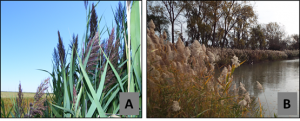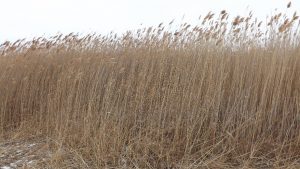Given Phragmites’ aggressive spread throughout the Great Lakes region, it is easy to forget that this invader takes a break for several months every winter! In fact, Phragmites has an annual biological cycle consisting of three separate phases: growing, translocating, and dormant. As we cruise through the growing phase right now, PAMF wants to bring to your attention to the differences between these phases and the management actions that are typically carried out in each phase.
Growing
We are currently in the growing season, which typically starts in mid-to-late spring as the cold weather makes way for warmer days. The beginning of Phragmites’ growing season is characterized by patches of old stems with lively, green shoots popping up from the soil (Figure 1). By late-July, these shoots will have grown into surprisingly tall, verdant stalks topped with an immature inflorescence (flower; Figure 1). These Phragmites patches will continue to grow by establishing their current domain and spreading to new territory until late summer.

Figure 1: (A) Early in the growing phase, you will find new shoots emerging from the soil amidst old stems. (B) Later in the growing phase, the stems will be tall, green and may or may not have immature inflorescences. Last year’s dead shoots may still be present.
PAMF’s program considers five management actions during the growing phase: flood, cut underwater, spading, glyphosate, and rest. Flooding and cutting underwater both attempt to cut off the plant’s oxygen supply whereas spading cuts the aboveground material to reduce its photosynthetic capacity. Although this is not a traditional time for herbicides, some research has shown that a June application of glyphosate can be surprisingly successful. Lastly, resting a management unit is the activity that is least burdensome on land managers because it requires them to do nothing. Resting may seem counterproductive when considered in isolation, but in almost all management combinations, it is paired with other management actions that are expected to place considerable stress on Phragmites.
Translocating
The translocating phase typically begins in late summer as the plants start moving photosynthates (products of photosynthesis) below ground for winter storage. You will know your patch has entered the translocating when the inflorescence matures (Figure 2). Later, the translocating phase is nearing its end when you see yellowing leaves and “fluffy” seed heads that are preparing seeds for wind dispersal (Figure 2).

Figure 2: (A) Early translocation is identified by inflorescences (flowers) that are in full bloom (colors can vary from a distinct purple to light yellow). (B) Later in the translocating phase, Phragmites’ leaves and stems will begin to turn yellow, and the inflorescence will become “fluffy” as it sets seed.
During translocation, the most common management actions involve the use of herbicides because the plants are actively transporting nutrients from the leaves to the roots, thereby delivering the plant-killing herbicides to the hardest-to-kill tissues. Other translocating management actions include cut underwater, spading, and rest. It is important to note that PAMF’s annual cycle begins with the translocating phase because this is the most active period of Phragmites management.
Dormant
The last biological phase is dormancy, which lasts throughout the winter. It can also be thought of as Phragmites’ annual break. During this phase, the aboveground tissue dies as all the nutrients have been moved from the leaves and stems to its nearly inactive root system for storage. You will know your patch is in the dormant phase when all the visible plants turn brown (Figure 3).

Figure 3: During the dormant phase, the aboveground tissues will be dead and brown. No new growth will have emerged yet.
Although Phragmites is taking a hiatus in its Great Lakes invasion during the dormant phase, land managers certainly are not. PAMF considers multiple dormant phase-specific management actions as well as a couple of repeat methods: remove biomass, mechanical (and leave biomass), pre-flood clearing, flood, and rest. The three mechanical methods all cut, crush, or burn the aboveground material with two goals in mind: 1) preparing for management actions later in the season (e.g., ensuring better herbicide coverage, flood preparation), and 2) fostering a more competitive environment by increasing the sunlight available to native seedlings.
Putting it All Together
Phragmites’ annual biological cycle—growing, translocating, and dormant—requires land managers, and PAMF, to think strategically about which management actions should be employed at various times of the year. In response to this, PAMF has selected management actions that correspond with each phase, and will review managers’ data to evaluate which combination of these actions is most effective and efficient at reducing Phragmites’ abundance.
For this process to work, we need you! The data collected by land managers are what drive the basin-wide learning. Look in this month’s newsletter for a training location near you, and please consider joining PAMF today. For more information, contact us at pamf@glc.org or check out PAMF’s website.
